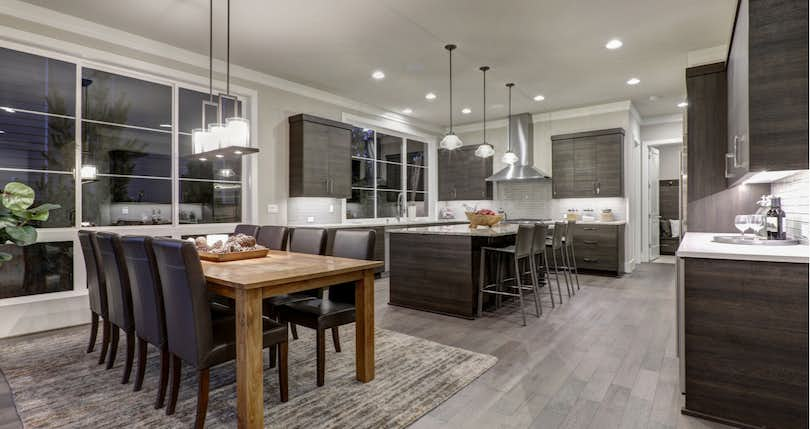Most current home designs include an open-floor-plan concept. But is that really what you want? Uncover the advantages and disadvantages of having an "open concept" home design before you buy.

If your home was built in the 90s, it’s most likely that your home boasts an open-floor-plan design. And once this new trend began, it took off and hasn’t slowed since. The majority of homes you walk into today will have an open-floor-plan layout.
So what exactly is an open-floor-plan?
An open-floor-plan is a type of home layout that expands and opens up space by combining multiple individual rooms into a single expansive living space.
Most commonly, open-floor-plans break down walls and divides between the kitchen, dining room, and living room in order to converge the rooms into one large space.
Also called a "great room" or "open concept," an open-floor-plan design can either be great or aggravating depending on your situation and home needs.
Advantages of an Open-Floor-Plan
Small Square Footage
An open-floor-plan is perfect for smaller homes. If you have less square footage to work with, opening up your home can not only add extra space but give you the feeling that your home actually is bigger.
By breaking down divides between small, cramped rooms, you’re also able to use the space more efficiently and for multi-purposes — you don’t have to be confined to one area when cooking or when you’re watching TV.
Easy to Be Social
This particular layout is great for entertaining guests or throwing parties. The open space allows your guests to easily mingle and to transition, for instance, from eating in the dining room to socializing in the living room.
With this layout, you as the host can also join in on the festivities. You don’t have to be locked in the kitchen cooking or preparing the appetizers. You’re able to effortlessly interact and be part of the party even when you’re in a different room.
Natural Light
By breaking down walls and opening up your space, more natural light will filter through and spread throughout your home. This can help brighten up your home and make the space feel bigger.
Parenting Made Easier
Without walls to hide behind, your kids will have to be on their best behavior. Or rather, you’ll at least be able to see them whenever they act up. The open-floor-plan allows you to do work in one room while always having an eye on your kids in the next.
Better Flow
With an open-floor-plan, your home feels more welcoming. You can easily move around without navigating long and poorly-lit hallways that can feel uninviting and claustrophobic.
So while all these pros of having an open-floor-plan seem great, before you pull out the sledgehammer and start knocking down walls, you’ll want to consider the disadvantages as well.
Disadvantages of an Open-Floor-Plan
Noisy
Sound travels. And especially with an open-floor-plan design, noise will travel further making it more difficult to escape the blaring television or the deafening ruckus when your kids play.
With more walls, dividers, and in essence, individual closed-off rooms, you’ll be able to shut out unwanted noise or at the very least reduce the intensity.
Hobby Rooms
If you don’t have a hobby already, you may want to pick one up, because without an open-floor-plan you’ll have plenty of room to dedicate to whatever you’d like.
Whether you turn the room into a reading room, an office, a play room, a craft room, or a workout room, is up to you. Either way, you’ll be sure to have enough space in a singular room to sprawl out.
Privacy
With an open-floor-plan, it’s all about socializing and being out in the open. However, sometimes you need your space.
Closed off rooms are also much more conducive to families operating on different schedules and who are different ages. Maybe the little one goes to bed early but you need to stay up late and work.
Cleaning
Open-floor-plan layouts can quickly become cluttered or messy. By separating rooms, you can confine the mess to one area and simply shut the door so you don’t have to contend with it until you’re ready.
Plus, by having a room to keep your clutter in, you can hide any mess or straggling kid toys for whenever guests come by.
Energy Costs
Simply put, large open spaces are more difficult to heat and cool. And usually with open-floor-plans, you’ll see more windows and higher ceilings which traditionally use up a lot of energy resources.
With smaller, individual rooms, you can more easily keep your utility bills under control.
Open-floor-plans come with both plenty of advantages and disadvantages. But whether you want an open-floor-plan concept in your home is completely dependent on your needs.
You’ll want to weigh the pros and cons carefully before you decide to purchase your new home. And to help you through that process, an experienced real estate agent can give you expert guidance and advice, helping you decide what design and style is right for you.




